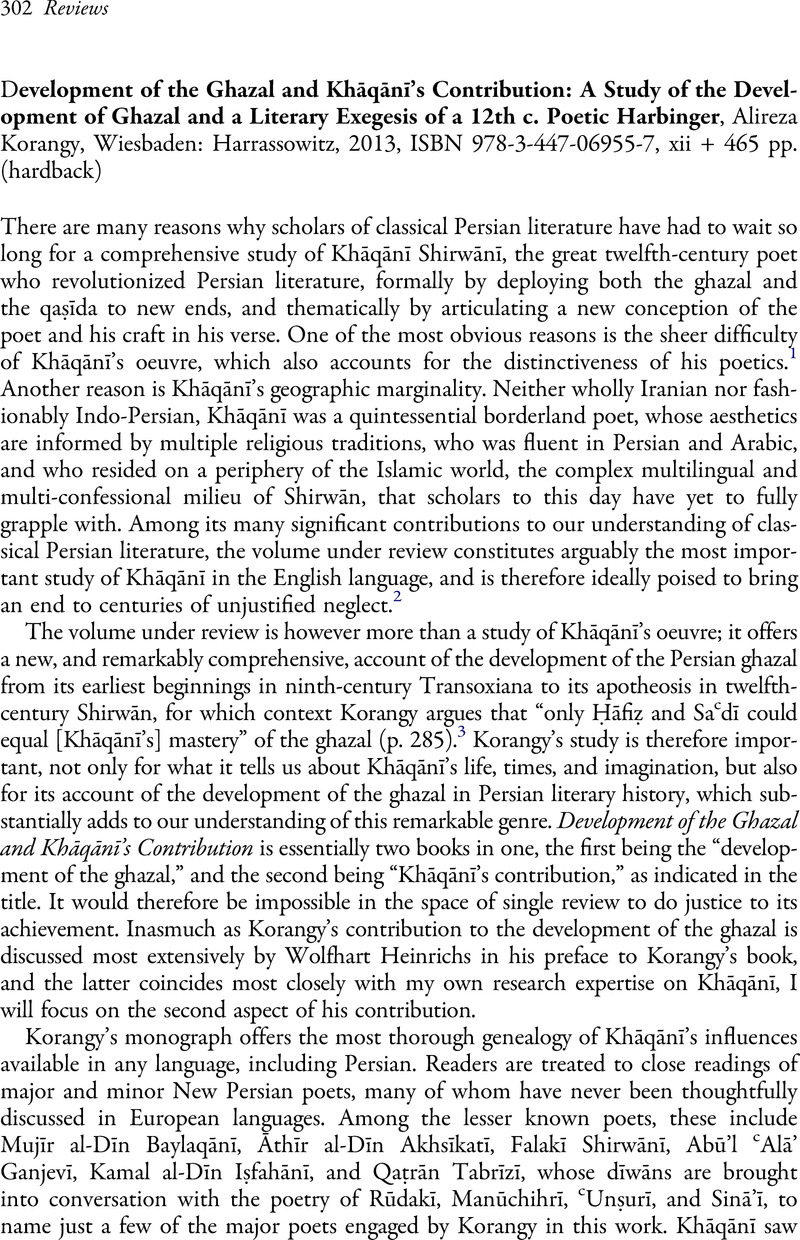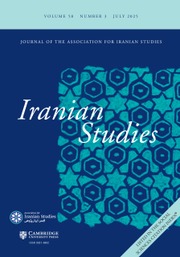No CrossRef data available.
Article contents
Development of the Ghazal and Khāqānī’s Contribution: A Study of the Development of Ghazal and a Literary Exegesis of a 12th c. Poetic Harbinger, Alireza Korangy, Wiesbaden: Harrassowitz, 2013, ISBN 978-3-447-06955-7, xii + 465 pp. (hardback)
Review products
Development of the Ghazal and Khāqānī’s Contribution: A Study of the Development of Ghazal and a Literary Exegesis of a 12th c. Poetic Harbinger, Alireza Korangy, Wiesbaden: Harrassowitz, 2013, ISBN 978-3-447-06955-7, xii + 465 pp. (hardback)
Published online by Cambridge University Press: 01 January 2022
Abstract
An abstract is not available for this content so a preview has been provided. Please use the Get access link above for information on how to access this content.

- Type
- Reviews
- Information
- Copyright
- Copyright © 2015, Rebecca Gould
References
Bahār, Malik al-Shuʿarāʾ. Sabkshināsī: Tārīkh-i taṭāvvur-i nathr-i Fārsī. Tehran: Amīr Kabīr, 1370/1991.Google Scholar
Bauer, Thomas and Neuwirth, Angelika, eds. Ghazal as World Literature. Beirut: Ergon Verlag, 2005.Google Scholar
Beelaert, A. L. F. A. A Cure for the Grieving: Studies on the Poetry of the 12th Century Persian Court Poet Khāqānī Širwāni. Leiden: Nederlands Instituut voor het Nabije Oosten, 1996.Google Scholar
Gould, Rebecca. “The Political Aesthetic of the Medieval Persian Prison Poem, 1100–1200” (PhD diss., Columbia University, 2012).Google Scholar
Gould, Rebecca. “ ‘I Bind Myself in the Belt of Oppression’: Khāqānī’s Christian Qaṣīda and the Prison Poetry of Medieval Shirwān.” Journal of Persianate Studies 8, no. 2 (2015), the work is forthcoming.Google Scholar
Gould, Rebecca, trans. After Tomorrow the Days Disappear: Ghazals and other Poems of Hasan Sijzi of Delhi. Evanston, IL: Northwestern University Press, forthcoming.Google Scholar
Kinra, Rajeev. “ Make it Fresh: Time, Tradition, and Indo-Persian Literary Modernity. ” In Time, History, and the Religious Imaginary in South Asia, edited by Murphy, Anne C.. pp. 12–39. London: Routledge, 2011.Google Scholar
Maḥjūb, Muḥammad Jaʿfar. Sabk-i Khurāsānī dar shiʻr-i Fārsī: barʹrasī-i mukhtaṣāt-i sabkī-i shiʻr-i Fārsī az āghāz ẓuhūr tā pāyān-i qarn-i panjum-i Hijrī. Tehran: Firdaws, 1967.Google Scholar
Minorsky, Vladimir. “ Khāqānī and Andronicus Comnenus.” Bulletin of the School of Oriental and African Studies 11, no. 3 (1945): 550–578. doi: 10.1017/S0041977X0007227XGoogle Scholar
Sharma, Sunil. Persian Poetry at the Indian Frontier: Mascud Sacd Salmān of Lahore. Delhi: Permanent Black, 2000.Google Scholar
Sharma, Sunil. “ Review of Hamid Dabashi, The World of Persian Literary Humanism.” International Journal of Middle East Studies 45, no. 4 (2013): 840–842. doi: 10.1017/S0020743813001104CrossRefGoogle Scholar
Shīrāzī, Aḥmad Bihishtī, and ḥamīd Ri ā Qilīch Khānī, eds. Dīvān-i ḥasan Dihlavī: sadah-i haftum va hashtum. Tehran: Anjuman-i Āsār va Mafākhir-i Farhangī, 2004.Google Scholar
ā Qilīch Khānī, eds. Dīvān-i ḥasan Dihlavī: sadah-i haftum va hashtum. Tehran: Anjuman-i Āsār va Mafākhir-i Farhangī, 2004.Google Scholar


